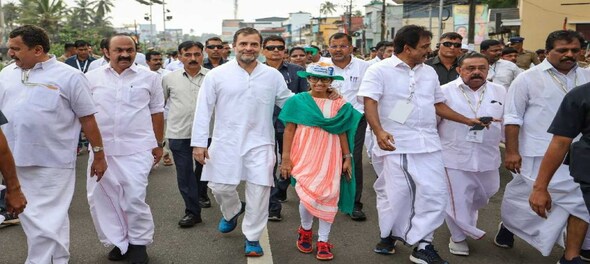
Within days of Rahul Gandhi’s 150-day-long Bharat Jodo Yatra taking off from Kanyakumari on its 3570-kilometre journey to Kashmir, the CPI(M) criticised the Yatra for spending 18 days in Kerala and just two in Uttar Pradesh.
This was waiting to happen. The Yatra, purportedly against growing 'hatred' in society, inflation, and unemployment, neatly skips the biggest strongholds of the BJP, from where the party draws the electoral heft to storm to power in the Lok Sabha.
It completely skips Gujarat -- which is about to go to polls, is the home state of the Prime Minister and is believed to be the original laboratory of Hindutva -- and barely touches the western fringe of Uttar Pradesh, the most populous state that has ensured two consecutive Lok Sabha majorities for the BJP. It skips entire eastern and north-eastern India, where the BJP has been expanding.
A Congress leader told this columnist that the touch-and-go entry into UP was also an after-thought that was necessitated by pressure from Congress workers there. So, the nearly vertical line from Kanyakumari to Kashmir takes a slight detour to barely touch UP around Bulandshahr.
The one state where the Yatra is extensive is Kerala. Its route in Kerala – where the BJP is virtually absent and the CPI (M) takes on the Congress in 2024 to guard its last bastion in India – goes through Thiruvanathapuram, Kochi and Nilambur. However, it is timed too far away from the Lok Sabha polls to impact even Kerala in a clear manner.
Also read | Congress will embark on a journey to ‘unite India’, but what about growing internal divisions
The Yatra does spend significant time in BJP-ruled Karnataka, passing through Mysuru, Bellari and Raichur, and then touches Telangana at Vikarabad before entering Maharashtra, where it passes through Nanded and Jalgaon Jamod. From Maharashtra, the Yatra travels through Malwa region of MP to enter Rajasthan at Kota. It travels through eastern Rajasthan via Dausa – once the constituency of Rajesh Pilot – and Alwar.
It then barely touches UP at Bulandshahr, goes to Delhi and passes through the eastern fringes of Haryana and Punjab to enter Jammu via Pathankot, the town in Punjab that is the entry point to Jammu and Kashmir. The Yatra is supposed to end in Srinagar.
The route shows that the Yatra is more effort than gain, as the 3500-kilometre walk, perhaps a first for any Indian politician, skips much of India's saffron belt, while purportedly being an answer to the BJP.
Unless Rahul Gandhi decides to take out another such Yatra next year – it won't be easy for Congress workers to crisscross the country in a row twice on foot – he may not fulfil his stated objectives.
The Yatra, in short, is short on symbolism.
Could there have been another route for it? Let me take a guess. The Yatra could have begun at Lal Chowk in Srinagar, with the hoisting of the tricolor and an endorsement of the now-abrogated Article 370. It could have then passed from Jammu to Pathankot in Punjab, recalling the terror attack there a few years back. It could then have entered Delhi after a significant journey through BJP-ruled Haryana, and entered UP. It could have gone through the sugarcane belt, the hub of the farm protests with significant Muslim populations. The next stop, turning south, could have been AMU in Aligarh, followed by a visit to Mathura-Brindawan. From here, the Yatra could have passed through Muslim-heavy Ruhelkhand and entered Awadh. After Lucknow, the Yatra chould have taken a halt at Ayodhya, with a speech by Gandhi focusing on the magnanimity of Lord Ram and going into the etymology of Ayodhya – a place that is free of war.
Gandhi could then have proceeded to Nehru's city, Prayagraj and camped at Varanasi, the Prime Minister's constituency. Here, he could have visited Kashi Vishwanath temple, the birthplace of Kabir, the home of late musician Ustad Bismillah Khan and Banaras Hindu University. Proceeding northwards to Azamgarh and Gorakhpur, the home town of Yogi Adityanath, Gandhi could have entered Bihar, inviting JD(U) and RJD leaders to join him. After Bodh Gaya in Bihar, the yatra could have entered Bengal via Jharkhand and travelled through the state, possibly with TMC leaders, to enter Assam. Travelling through Assam and Tripura, the Yatra could have been concluded in Arunachal Pradesh, underlining the unity of India.
A Yatra of this kind would have challenged the BJP in multiple bastions, and also visited places that have been in news for various reasons.
Also read | From LK Advani's Rath yatra to Congress Bharat Jodo Yatra: Path politicians took to people's hearts
Imagine the impact of a speech at Gorakhpur on the razing of constructions with the use of bulldozers. It would have made it to page 1 in every newspaper and dominated TV channels.
However, Rahul Gandhi's advisors chose 'safer' stretches of the country for his arduous trek.
Given the choice of route, the Bharat Jodo Yatra may not be able to make the intended impact, unless another similar Yatra through the Gangetic plains is being planned for 2023.
— Vikas Pathak is a columnist and media educator. The views expressed are his own.
Check out our in-depth Market Coverage, Business News & get real-time Stock Market Updates on CNBC-TV18. Also, Watch our channels CNBC-TV18, CNBC Awaaz and CNBC Bajar Live on-the-go!


Lok Sabha elections 2024: From Wayanad to Shivamogga, key battles in the second phase
Apr 25, 2024 2:01 PM
EC probes allegations of MCC violation by Modi, Rahul; seeks response by April 29
Apr 25, 2024 1:32 PM
LS polls phase 2: Rahul Gandhi, Shashi Tharoor in fray; Hema Malini, Om Birla eyeing hat-trick
Apr 25, 2024 12:19 PM
UP constituencies to witness three-cornered fight in second phase tomorrow
Apr 25, 2024 10:47 AM

